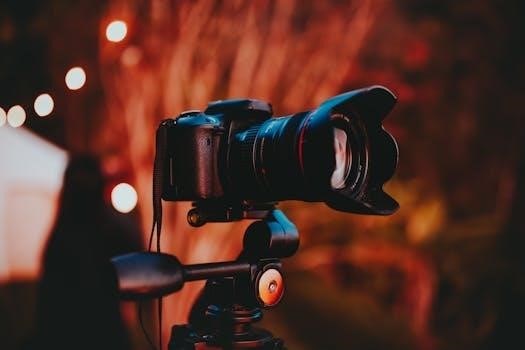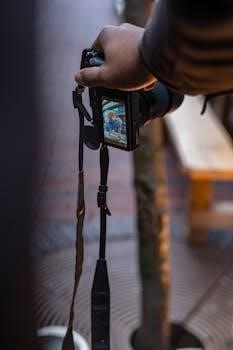Understanding the Exposure Triangle
The exposure triangle is a foundational concept in photography, illustrating the relationship between aperture, shutter speed, and ISO. Adjusting one setting requires balancing the others to achieve the desired exposure for your image.
The Relationship Between Aperture, Shutter Speed, and ISO
Understanding how aperture, shutter speed, and ISO interact is crucial for achieving proper exposure. Aperture controls the lens opening, affecting light and depth of field. Shutter speed dictates how long the sensor is exposed to light, impacting motion blur. ISO determines the sensor’s sensitivity to light. Adjusting one requires compensating with the others to maintain a balanced exposure. The interplay of these three settings allows you to create images that are neither too dark nor too bright, and that also have the desired level of sharpness and depth.
Aperture Explained
Aperture, the lens opening, controls the amount of light reaching the camera sensor. It’s measured in f-numbers; a smaller f-number means a wider opening, letting in more light.
Controlling Depth of Field and Brightness
Aperture significantly impacts both brightness and depth of field. A wider aperture (smaller f-number) allows more light, creating a brighter image and a shallow depth of field, blurring the background. Conversely, a narrower aperture (larger f-number) results in less light, a darker image, and a greater depth of field, keeping more of the scene in focus. Choosing the right aperture is crucial for balancing image brightness and the desired focus effect.
Shutter Speed Defined
Shutter speed refers to the duration the camera’s shutter remains open, letting light reach the sensor. It’s measured in fractions of a second, controlling motion capture in a photo.
Freezing or Blurring Motion
Shutter speed is crucial for controlling how motion appears in your photographs. Faster speeds, like 1/500th of a second or quicker, can freeze fast-moving subjects, capturing sharp details without blur. Conversely, slower speeds, such as 1/60th of a second or longer, create motion blur, ideal for conveying movement or a sense of speed. The choice of shutter speed depends on the desired effect and the subject’s motion, which plays a vital role in creative photography. Understanding this relationship allows photographers to make intentional choices for capturing motion within the frame.
ISO Sensitivity
ISO determines your camera’s sensitivity to light. Higher ISO settings are used in low-light situations, but can introduce digital noise or grain. Lower ISO values create cleaner, less noisy images in bright light.
Adding or Subtracting Film Grain
ISO sensitivity, akin to film speed, directly influences the presence of grain or noise in your photographs. Lower ISO settings, such as 100 or 200, minimize grain, resulting in smoother, cleaner images ideal for bright conditions. Conversely, higher ISO values, like 800, 1600, or even 3200, amplify the signal, making it possible to capture images in low-light scenarios, but at the cost of increased grain. This trade-off allows for creative control, where noise can be intentionally added for an artistic effect, resembling the grain of traditional film. Therefore, choosing the correct ISO is crucial for image quality.

The Exposure Triangle Chart
A visual representation of the exposure triangle helps understand the interplay of aperture, shutter speed, and ISO. Charts demonstrate how adjustments to one element impact the others to maintain proper exposure.
Visualizing the Interplay of Settings
The exposure triangle chart visually represents how aperture, shutter speed, and ISO interact. It demonstrates that changing one setting necessitates adjustments to others for balanced exposure. A chart helps to understand that a wider aperture (lower f-number) allows more light, requiring faster shutter speeds or lower ISO to prevent overexposure. Conversely, a narrower aperture (higher f-number) needs slower shutter speeds or higher ISO. This interplay is crucial for capturing well-exposed images under varying lighting conditions and achieving desired effects, like motion blur or depth of field.

Aperture Priority Mode
In aperture priority mode, the photographer selects the desired aperture (f-number), and the camera automatically calculates the appropriate shutter speed to achieve correct exposure, based on the lighting conditions and ISO.
Camera Sets Shutter Speed Based on Aperture
When using aperture priority mode, the camera’s primary function is to automatically adjust the shutter speed to ensure a well-exposed photograph. You, as the photographer, have control over the aperture (f-number), which influences the depth of field and the amount of light entering the lens. The camera then analyzes the scene’s lighting and chooses a corresponding shutter speed. This ensures the sensor gets the right amount of light for a properly exposed shot. It simplifies the process of controlling depth of field while keeping the exposure balanced, as the camera manages the shutter speed;

Shutter Priority Mode
In shutter priority mode, you select the shutter speed, and the camera automatically adjusts the aperture to achieve a balanced exposure. This mode is ideal for controlling motion blur.
Camera Sets Aperture Based on Shutter Speed
When using shutter priority mode, the camera intelligently selects the appropriate aperture setting to match your chosen shutter speed. For instance, a fast shutter speed will prompt the camera to use a wider aperture to allow more light in, while a slow shutter speed will cause it to choose a narrower aperture. This automatic adjustment ensures proper exposure of your image by balancing the amount of light reaching the sensor according to your preferred motion control, allowing you to focus on capturing the subject and desired movement effect.
Practical Examples
Imagine using f/2.8 for a blurred background, then choosing a 1/100s shutter speed to avoid motion blur. Finally, set ISO 800 to achieve proper exposure. These settings show practical application.
Applying Settings in Different Scenarios
Consider shooting a portrait with a wide aperture like f/2.8 for a blurred background, requiring a faster shutter speed, maybe 1/250s, to prevent overexposure. In bright sunlight, use a low ISO (100-200) for optimal quality. Alternatively, for sports, prioritize a fast shutter speed like 1/500s to freeze motion, possibly needing a wider aperture and higher ISO if light is low. These adjustments show how to apply settings to various situations for the best results.

Balancing Exposure
Achieving the right exposure requires a careful balance of aperture, shutter speed, and ISO. Understanding how these three settings interact is essential for creating well-exposed and visually appealing photographs.
Achieving the Desired Image
To achieve the desired image, photographers must skillfully manipulate the exposure triangle’s components⁚ aperture, shutter speed, and ISO. By carefully adjusting each of these settings, one can control the brightness, depth of field, and motion blur within a photograph. For example, a wide aperture allows for shallow depth of field, while a fast shutter speed freezes motion. Balancing these parameters with the appropriate ISO level ensures a well-exposed and aesthetically pleasing outcome. Therefore, mastering these three elements is key to artistic expression in photography.